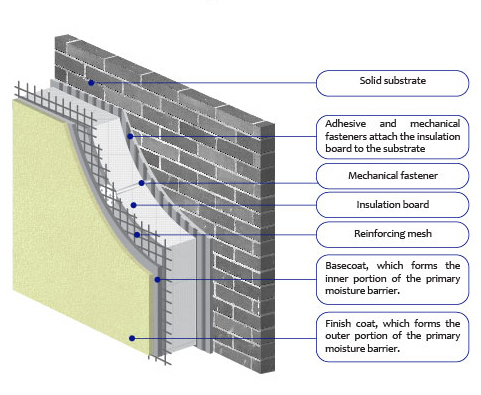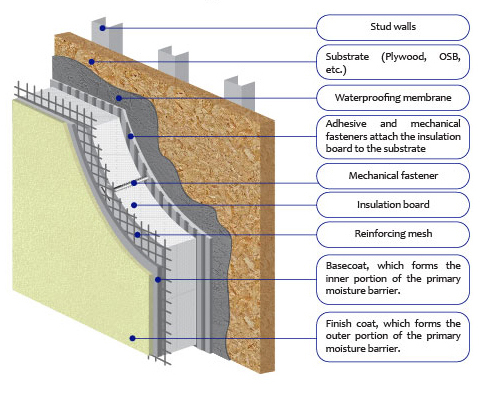An Exterior Insulation Finishing System (EIFS), also known as EWI (Exterior Wall Insulation Systems) or External Thermal Insulation Composite Systems (ETICS) is a type of cladding system that provides exterior walls with an insulated finished surface and waterproofing in an integrated composite material system. Put another way, an Exterior Insulation Finishing System / External Thermal Insulation Composite Systems can be defined as an ideal energy efficient thermal wrapping or facade insulation applied to the exterior surfaces of a building which is then finished with a long-life, decorative and protective wall coating that can be installed on any type of construction.
In the construction industry, there are a number of versions of EIFS / ETICS. The most basic and common EIFS / ETICS is called a barrier EIFS, also known as traditional or conventional EIFS / ETICS, which is applied to a solid wall (brickwork, blockwork, pre-cast panels and the like). Another type is called EIFS / ETICS with drainage, which is a barrier EIFS / ETICS to which a water drainage capability has been added. This is done mainly for wood structures.
Sectional view of typical EIFS / ETICS facade insulation on a solid wall

Sectional view of typical EIFS / ETICS on a wood substrate

While similar in appearance to stucco (or conventional rendered plaster), EIFS / ETICS is an exterior wall cladding system that consists of components and installation requirements very different from traditional stucco. EIFS / ETICS also requires very different care and maintenance than its “look-alike” cousin, traditional EIFS stucco.
To function properly, EIFS / ETICS needs to be architecturally designed and installed as a system by trained applicators.
EIFS / ETICS Components
While giving the appearance of stucco (or conventional rendered plaster), EIFS / ETICS is actually a multi-layered wall system that consists of the following components:
The History of Terraco EIFS / ETICS
Terraco first launched its EIFS / ETICS systems in Turkey and Korea in the 1980s, which was then expanded to Russia, China and the Middle East during the 1990s. Today Terraco offers 3 different EIFS /ETICS systems – EIFS Alpha, EIFS Polar and EIFS Perma – the difference being the type of insulation materials used in each system. Terraco also offers a system for insulated concrete form - ICF Zenith.
History of EIFS / ETICS
1950s
1960s
1970s
1980s
1990s
By the turn of the century, in Europe, the decisions by numerous governments to introduce an energy rating system on buildings supported by government aided funding / rebates has seen as rapid growth of EIFS. While the use of EIFS over stud-and-sheathing framing (instead of over solid walls) is a technique still used all over North America, certain parts of Europe and the Pacific Rim.
The EIFS / ETICS industry now faces the challenge of formulating fire-resistant Exterior Insulation Finishing Systems, through the use of incorporating fire retardant materials and / or fire breaks in the system, something Terraco has been focussing on for quite some time.